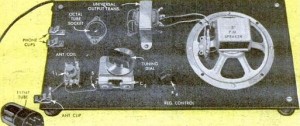 Fido is shown here assisting with the construction of this simple one-tube radio from the January 1947 issue of Popular Mechanics. The radio is a very simple regenerative receiver described as a “student set.” The tuning range is 550-1200 kHz, meaning that the top part of the AM broadcast band is cut off. The article notes that this limited tuning range was used “for simplicity and to enable the builder to find the component parts in current radio catalogs.” In particular, instead of having the builder wind the coil, the plans call for a standard oscillator coil intended for a superheterodyne receiver.
Fido is shown here assisting with the construction of this simple one-tube radio from the January 1947 issue of Popular Mechanics. The radio is a very simple regenerative receiver described as a “student set.” The tuning range is 550-1200 kHz, meaning that the top part of the AM broadcast band is cut off. The article notes that this limited tuning range was used “for simplicity and to enable the builder to find the component parts in current radio catalogs.” In particular, instead of having the builder wind the coil, the plans call for a standard oscillator coil intended for a superheterodyne receiver.
 The receiver uses a single 117N7 tube, which combines a pentode and rectifier in the same tube. Therefore, both the filaments and the B+ can be obtained from an AC line cord. The chassis is simply a wooden base supported by cabinet knobs. Most of the wiring is under the chassis, although the high voltages are easily accessible to anyone who picks up the radio when it’s plugged in, which probably wouldn’t fly today. The radio puts out enough audio to drive a 5″ speaker, which is simply mounted facing down.
The receiver uses a single 117N7 tube, which combines a pentode and rectifier in the same tube. Therefore, both the filaments and the B+ can be obtained from an AC line cord. The chassis is simply a wooden base supported by cabinet knobs. Most of the wiring is under the chassis, although the high voltages are easily accessible to anyone who picks up the radio when it’s plugged in, which probably wouldn’t fly today. The radio puts out enough audio to drive a 5″ speaker, which is simply mounted facing down.
As with many Popular Mechanics electronic projects, the set was also available in kit form from Allied Radio. It could be found in the 1948 catalog for $10.50.
Most of the parts should be readily obtainable. The most difficult would be the coil, but it is available from Antique Electronic Supply. It could also be scavenged from an old five-tube AM radio. The tube is available from TubeDepot.com. For more ideas on where to find parts, you can visit my Crystal Set Parts page or Jameco Electronics.
